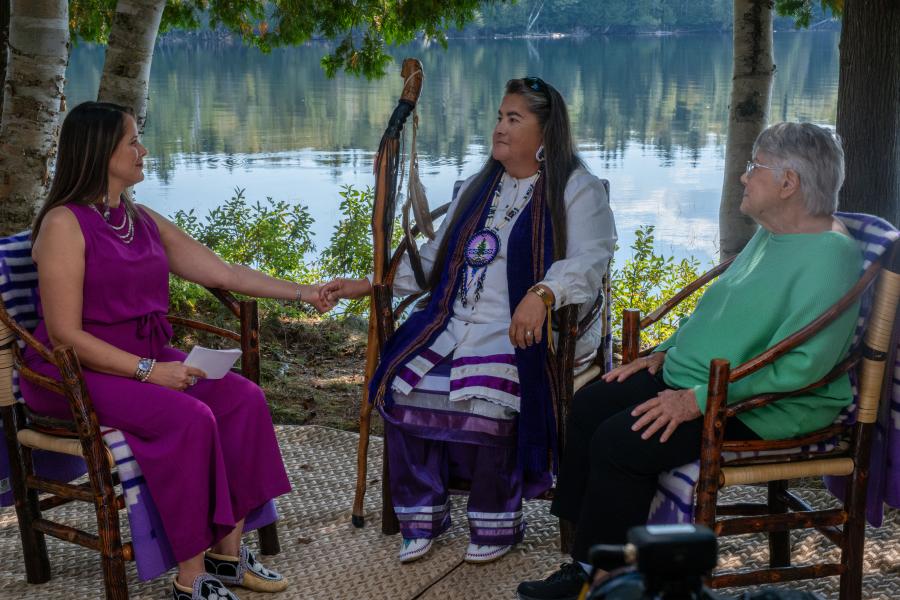In the vast spaces of the U.S. Sourthwest, the Navajo are embracing the internet to improve social services and protect their culture.
When Denise Ganadonegro first started working as the community services coordinator for the Alamo Chapter of the Navajo Nation, she mostly heard from residents when they had complaints.
“ The community was telling us that we need services here, asking why don’t we have any,” Ganadonegro said.
At that time, in 2002, most government-coordinated infrastructure planning and development took place in Window Rock, Arizona, 490 miles away from Alamo. To meet with Navajo Nation officials and submit applications for capital improvement projects and funding, Ganadonegro and her colleagues had to spend days away from the chapter.
But since the Navajo Nation brought wireless internet to the reservation in 2003 and allowed chapters to take control of their own projects, Ganadonegro said complaints have largely ceased.
Internet connectivity via satellite has allowed the Alamo Chapter, which has a population of 2,500 and is located in central western New Mexico to become less dependent on the central Navajo government and more efficient, Ganadonegro said. Since 2003, the chapter has built a new court house and has nearly finished construction of a fitness center and baseball field. The chapter expects work to begin soon on a new senior center and youth club, and plans to install a cellular phone tower.
The Navajo Nation first began installing the wireless network in 2000 as a means to implement the Local Governance Act (LGA), which had been passed in 1998 to encourage the Navajo Nation’s 110 chapters to become more self-sufficient, said Ernest Franklin of the Navajo Nation Department of Capital Improvements.
Five communities in the southwestern section of the reservation, which came together as the Southwest Virtual Alliance, installed the Navajo Nation’s first internet service. The group won a grant from the U.S. Department of Commerce and was given two years to install a system. But because many of the communities did not have phone lines, installing a wired system would have taken too long. The alliance decided to opt for the less time-consuming and cheaper wireless satellite option, and participated in a satellite internet pilot project with Virginia-based Starband. This project laid the groundwork that in 2000 helped the Navajo Nation win a grant from the Bill and Melinda Gates Foundation to install computers in all 110 chapter house and 273 Head Start pre-kindergarten centers. The foundation also gave the Nation $2 million to install a satellite system to cover the reservation. OnSat, a satellite company based in Park City, Utah, submitted the winning bid to complete the project and has opened a mostly Navajo-staffed operation on the reservation to maintain it.
One of the major LGA components chapters can now access on the internet is an Infrastructure Capital Improvement Planning (ICIP) website (icip.nncio.org). This allows chapters to report the capital assets they already have and evaluate and plan for building repair and equipment needs.
“ The ICIP website really paved the way for us to put in some of the projects that we needed for the community,” said Elizabeth Harrison, community services coordinator for the Gadii’ahi Chapter, which is in the far northwest corner of New Mexico near the city of Shiprock. Now the website allows members of the Gadii’ahi community to know how their chapter house is spending money. Most chapters have involved their communities in prioritizing which improvement projects to pursue. “We’re all accountable for the money the chapter receives, and the inventory helps us to know what we have,” Harrison said. “Whatever purchases we make for the community, we have a running account for their receipt.”
When the Gadii’ahi Chapter, home to about 1,500 people, started developing its own ICIP plan, residents told their leaders that one of their most pressing needs was to replace an irrigation canal that the largely agricultural community had built by hand in 1940. With the help of ICIP, the chapter secured $300,000 from New Mexico to build a new canal.
Tradition and Technology
A Navajo legend tells of a time when monsters had taken over the Earth and killed all the Navajo people, leaving two twins. The twins were taken in by Spider Woman, who told them that they had come from the sun, and counseled them about the obstacles they would need to overcome to go back to the sun and meet their father. The twins traveled to the sun and met those obstacles, and then passed the tests their father gave them to prove that they were his. The sons told their father about the monsters that were plaguing the Earth and asked him for arrows with which they could fight. With those weapons, the twins returned to Earth, destroyed the monsters, and freed the Navajo Nation.
“Today there are still monstrosities among us,” Navajo Nation President Joe Shirley told participants at the Ottawa, Canada, indigenous peoples preparation meeting for the World Summit on the Information Society in March. “Hunger, thirst, poverty, greed, ignorance, apathy, and all manner of diseases that are blind to race, color, and age. Today indigenous peoples must use the arrows of 0’s and 1’s [the numbers used in coding computer programs] and satellites. Information is a way to overcome today’s monsters.”
As the wireless network has helped individual chapter houses become better service providers for their populations, it has also bridged generations, helped teachers do their jobs better, given youth a role in the community, and allowed senior citizens to pass on traditional Navajo culture.
Youth have played a vital role in developing the wireless system. Summer interns in 2004 developed the ICIP reporting site and about 300 youth will work with Franklin in the summer of 2005. Some chapters have created programs in which youth teach elders to use computers that have been installed in senior centers. In return, the elders teach the youth traditional Navajo stories.
“ The kids are the ones who are driving this project,” Franklin said. “They are saying we need it. When adults saw the kids lining up at the chapters houses to get on the internet, it sparked their interest.”
Since 2002, all of the reservation’s Head Start schools have connected to the internet via satellite. Some teachers, who were hired before they graduated from high school, are using online programs to earn their high school equivalency diplomas and complete university degree programs in early childhood education. Many Head Start teachers also use online resources to plan their classroom curricula and find out about changing federal requirements, said Lavina Barton, program manager for the Navajo Nation’s Department of Early Childhood Development. For example, the Navajo Nation was able to easily adapt to the reporting requirements of President George W. Bush’s 2002 No Child Left Behind Act. To help ease teachers’ transition to the new teaching style required by the legislation, the Navajo Nation Head Start website (www.nnheadstart.org) provides guidelines for a new curriculum, called the Ádééhoniszin Dooleel Curriculum, that integrates the traditional Navajo philosophy of learning with the Western theory of child development and the legislation’s mandates. The website will soon include video tutorials for veteran teachers still trying to master the new guidelines.
The wireless network has also helped put the central Head Start office in better communication with its schools, and Head Start staff in better touch with the families they serve. Last year the program introduced software that allows teachers to report weekly attendance counts as well as immunization records and standardized test results to the central administration. Field managers who once spent most of their time shuttling paper records between Head Start centers and Window Rock can now spend most of their time working in communities, where families face a glut of social problems due to the reservation’s 50 percent unemployment rate, Barton said.
The Navajo Model
Franklin and his colleagues have started sharing the story of their success with indigenous peoples throughout the world. Apart from the Ottawa meeting, they have made presentations to other international and national audiences, including the February meeting of the U.S. National Reservation Economic Summit and Business Trade Fair in Las Vegas, Nevada. Visitors to the reservation from Brazil, El Salvador, Ghana, and Honduras have labeled the network the “Navajo Model.”
Although some Navajo are still wary of integrating Western technology into their lives, seeing the wireless network in action is gradually changing their minds. As the Navajo have done many times before, Franklin said, they are adapting a foreign invention and makingit their own.
“We used the silver that came from outside and learned to silversmith and became world-renowned for that,” Franklin said. “We took the technology of weaving and made it our own and we’ve become world-renowned. Internet technology is a tool that has come from outside. Now we have to take that and become world-renowned.”
Tara Tidwell Cullen is the managing editor of Cultural Survival’s publications.



